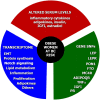Obesity and Breast Cancer: Molecular Interconnections and Potential Clinical Applications
- PMID: 26865587
- PMCID: PMC4828118
- DOI: 10.1634/theoncologist.2015-0351
Obesity and Breast Cancer: Molecular Interconnections and Potential Clinical Applications
Abstract
Obesity is an important risk factor for breast cancer (BC) in postmenopausal women; interlinked molecular mechanisms might be involved in the pathogenesis. Increased levels of estrogens due to aromatization of the adipose tissue, inflammatory cytokines such as tumor necrosis factor-α, interleukin-6, and prostaglandin E2, insulin resistance and hyperactivation of insulin-like growth factors pathways, adipokines, and oxidative stress are all abnormally regulated in obese women and contribute to cancerogenesis. These molecular factors interfere with intracellular signaling in the mitogen-activated protein kinase and phosphatydilinositol-3-phosphate/mammalian target of rapamycin (mTOR) pathways, which regulate the progression of the cell cycle, apoptosis, and protein synthesis. In this context, structural defects of typical genes related to both BC and obesity, such as leptin, leptin receptor, serum paraoxonase/arylesterase 1, the fat mass and obesity-associated gene and melanocortin receptor 4, have been associated with a high or low risk of BC development. The early detection of these gene alterations might be useful as risk predictors in obese women, and targeting these pathways involved in the BC pathogenesis in obese women is a potential therapeutic tool. In particular, mTOR pathway deregulation concurs in both obesity and BC, and inhibition of this might disrupt the molecular interlinks in a similar manner to that of metformin, which exerts definite anticancer activity and is currently used as an antidiabetic drug with a weight-reducing property. The identification of both genetic and pharmacological implications on the prevention and management of BC is the ultimate aim of these studies.
Implications for practice: Obese women are at risk of breast cancer, but clinicians lack concrete tools for the prevention or early diagnosis of this risk. The present study, starting from the biology and the molecular defects characterizing both obesity and breast cancer, analyzed the potential molecules and genetic defects whose early identification could delineate a risk profile. Three steps are proposed that are potentially achievable in the clinical assessment of obese women, namely the evaluation of altered levels of serum molecules, the identification of genetic polymorphisms, and the study of the transcriptomic profile of premalignant lesions. Finally, the therapeutic implications of this molecular assessment were evaluated.
摘要
肥胖是绝经后女性乳腺癌的重要危险因素, 发病机制可能涉及共通的分子机制。肥胖女性的脂肪组织芳香化导致的雌激素水平升高、炎性细胞因子 (如肿瘤坏死因子α、白介素6、前列腺素E2) 、胰岛素抵抗和胰岛素样生长因子旁路超活化、脂肪细胞因子及氧化应激均处于调节异常状态并可促进癌症形成。这些分子因素干扰细胞内信号转导中的丝裂原活化蛋白激酶和磷脂酰肌醇-3-磷酸/哺乳动物雷帕霉素靶蛋白 (mTOR) 通路, 而这些通路可调控细胞周期进展、凋亡和蛋白质合成。因此, 与乳腺癌和脂肪均相关的典型基因 (如瘦素、瘦素受体、血清对氧磷酶/芳香酯酶1、脂肪量与肥胖相关基因和黑素皮质素受体4) 的结构缺陷与乳腺癌发生风险升高或降低有关。早期发现这些基因改变可能有助于预测肥胖女性的风险, 针对肥胖女性中这些乳腺癌发病机制涉及的通路进行治疗也可能具有潜力。特别是肥胖和乳腺癌都会发生mTOR通路调节紊乱, 对其加以抑制也许能破坏二者的分子内在联系, 类似当前作为具有减轻体重作用的降糖药使用的二甲双胍却能发挥确切的抗癌活性那样。这些研究的终极目标是确定乳腺癌管理和预防措施的遗传和药理学意义。The Oncologist 2016;21:404–417
对临床实践的提示: 肥胖女性有发生乳腺癌的风险, 但临床医生缺乏具体的工具以预防或早期诊断这种风险。本研究中, 开篇讲述了肥胖和乳腺癌的生物学和分子缺陷特征, 分析了通过早期鉴别分子和基因缺陷可能绘制出风险谱。我们对肥胖女性的临床评估提出了三个可能达到的步骤, 即对血清分子水平的改变进行评价、鉴别基因多态性, 以及对癌前病变的转录组学特征进行研究。最后, 我们评价了这一分子评估的治疗意义。
Keywords: Adipokines; Breast cancer; Insulin resistance; Obesity; Polymorphisms; Risk factors.
©AlphaMed Press.
Conflict of interest statement
Disclosures of potential conflicts of interest may be found at the end of this article.
Figures




References
-
- World Cancer Research Fund/American Institute for Cancer Research . Food, Nutrition, Physical Activity, and the Prevention of Cancer: A Global Perspective. Washington, DC: AICR; 2007.
-
- Key TJ, Appleby PN, Reeves GK, et al. Body mass index, serum sex hormones, and breast cancer risk in postmenopausal women. J Natl Cancer Inst. 2003;95:1218–1226. - PubMed
-
- Renehan AG, Tyson M, Egger M, et al. Body-mass index and incidence of cancer: A systematic review and meta-analysis of prospective observational studies. Lancet. 2008;371:569–578. - PubMed
-
- Vainio H, Bianchini F.Weight Control and Physical Activity, Vol. 6. IARC Handbook of Cancer Prevention Lyon, France: IARC Press; 2002:1–315.
Publication types
MeSH terms
Substances
LinkOut - more resources
Full Text Sources
Other Literature Sources
Medical
Miscellaneous

